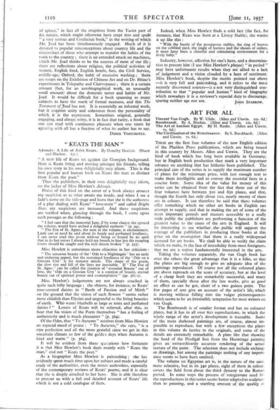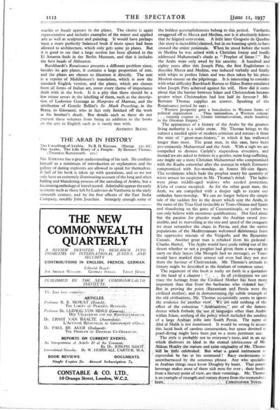ART FOR ALL
Vincent Van Gogh. By W. Uhde. (Allen and Unwin. ros. 6d.) Rembrandt. By A. Bredius. (Allen and Unwin. mos. 6d.) The Art of Ancient Egypt. By H. Ranke. (Allen and Unwin.
75. 6d.) The Civilisation of the Renaissance. By S. Burckhardt. (Allen and Unwin. 75. 6d.)
THESE are the first four volumes of the new English edition of the Phaidon Press publications, which are being issued
in this country by Messrs. Allen and Unwin. They are the kind of book which has long been available in Germany, but in English book production they mark a very important advance on anything that hai hitherto been published. The
principal aim of the series is to supply the maximum number of plates for the minimum. price, with just enough text to
make them intelligible and to convey the essential facts in a concise form. Some idea of the value for money of this series can be obtained from the fact that three out of the four volumes have between 300 and 65o plates, and that,
though the fourth has only about 103, nearly twenty of them are in colours. It can therefore be said that these volumes
offer something which no other art books in English can attempt to supply, and that in making the art of some of the most important periods and masters accessible to a really wide public the publishers are performing a function of the greatest value to the cause of the arts in England. It will be interesting to see whether_ the-public will support the courage of the publishers in, producing these books at this price on the assumption that there is a really widespread demand for art books. We shall be able to verify the claim which we make, in the face of incredulity from most foreigners, that we are a nation fundamentally interested in the arts.
Taking the volumes separately, the van Gogh book has over the others the great advantage that it is a folio, so that the plates are big enough to give an'- adequate idea of the paintings reproduced. Of course not all the coloured plates are above reproach on the score of accuracy, but at the level of a cheap book they are remarkably successful, and many of them, specially those after the late works, give as good an effect as can be got, short of a two guinea print. The few pages of text give an account of the artist's life, which is moving without falling into the vulgar picturesqueness which seems to be an irresistible temptation for most writers on van Gogh.
The Rembrandt is of smaller format and has no coloured plates, but it has in all over 6on reproductions, in which the whole range of the artist's development is traceable. Some of the more darkened paintings are, of course, almost im- possible to reproduce, but with a few exceptions the plates in this volume do justice to the originals, and some of the details are extremely remarkable. A plate like that showing the head of the Prodigal Son from the Hermitage painting gives an extraordinarily accurate rendering of the actual texture of the paint. The selection does not include etchings or-drawings, but among the paintings nothing of any import- ance seems to have been omitted.
The volume on Egyptian art is, in the nature of the case, more selective, but in its 34o plates, eight of therit in colour,
covers the field from about the third dynasty to the Roman period. In some ways the process of rotogravure used fol- the reproductions in this series seems better adapted to sculpture than to painting, and a -startling -amount - of the quality of
marble or basalt appears in the plates. The choice is again representative and includes examples of the minor and applied arts as well as sculpture and painting. It would have perhaps been a more perfectly balanced book if more space had been allowed to architecture, which only gets some 30 plates. But it is good to see that a large section has been allotted to the El Amarna finds in the Berlin Museum, and that it includes the best heads of Akhnaton.
Burckhardt's Renaissance presents a different problem since, besides its 400 plates, it contains a large proportion of text, and the plates are chosen to illustrate it directly. The text is a reprint of Niichilemore's translation, which is now the standard English version, arid the plates, which are chosen from all forms of Italian art, Cover every theme of importance dealt with in the book. It is a pity that there should be a few minor errors in the labelling of them, such as the descrip- tion of Lodovico Gonzaga as Margrave of Mantua, and the attribution of Gentile Bellini's St. Mark Preaching, in the Brera, to -Giovanni, who in fact only finished off the work at his brother's death. But details - such as these do not prevent these volumes from being an addition to the books on the arts in English such as is rarely met with.
ANTHONY BLUNT.

























































 Previous page
Previous page